Australian
and international
exploratory
performance and
media arts
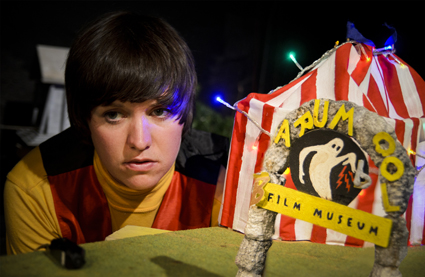
Natalie Randall, Rhubarb Rhubarb, Some Film Museums I Have Known
photo Lucy Parakhina
Natalie Randall, Rhubarb Rhubarb, Some Film Museums I Have Known
LIKE ALICE DOWN THE RABBIT HOLE, I HAVE TUMBLED DOWN THE STEPS OF GOODGOD DANCETERIA (ONE OF THE SMALL BARS NOW POPULATING SYDNEY SINCE THE CHANGE IN LICENSING LAWS) AND FOUND MYSELF IN AN ALTERNATE UNIVERSE OR, RATHER, A KIND OF ‘META-VERSE.’ YOU KNOW THE SORT—A WORLD WHERE THE BOOKS ARE ABOUT BOOKS, THE FILMS ABOUT FILM AND, IN THE CASE OF THE IMPERIAL PANDA FESTIVAL, THE PERFORMANCES ABOUT PERFORMANCE.
rhubarb rhubarb
Rhubarb Rhubarb’s Some Film Museums I Have Known is an extended riff on the relationship between technologies of magic (holograms, dioramas, toy trains, tiny cameras, live feeds, films etc) and the magic of storytelling (see a snippet on YouTube). It starts with a pitch for a film which is part adventure, part action, part fiction, part science fiction, part comedy, part tragedy, part romance and of course completely clichéd. Our heroine’s (Natalie Randall) obsession with film is such that not only is she pitching scripts but also a plan to establish a film museum at Barumpool. Hovering above her, and interjecting at will, are the holographic Lumiere brothers (Nick Coyle), who might be in her mind or an installation in the coming museum, but are probably both. The script (Eddie Sharp and Kenzie Larsen) risks collapsing under the weight of so many citations, but Will Mansfield’s imaginative set and Randall’s endearing performance ensure that it holds strong. There is much more to say about how screens and screen culture have changed stories and our ability to tell them, but by placing Some Film Museums I Have Known on stage (as opposed to say in an interactive installation), Rhubarb Rhubarb suggests that performance might be the most magical technology of all.
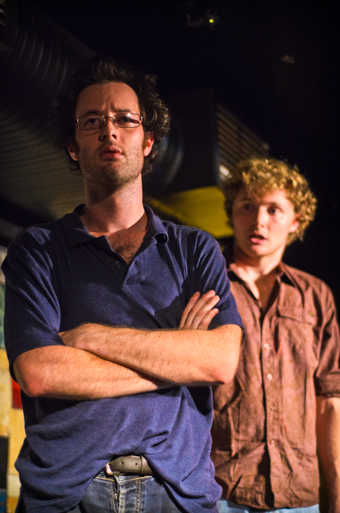
Gareth Davies and Charlie Garber, Masterclass
photo Lucy Parakhina
Gareth Davies and Charlie Garber, Masterclass
gareth davies, charlie garber
Masterclass is a show about the elusive art of acting. Born to a mother who worked in the chorus of Les Miserables, Gareth (Gareth Davies) has spent his entire life on stage. In the absence of any actual part in the musical, he has invented the character Charlie Garber (Charlie Garber), who becomes so life-like, scene-stealing and all-consuming that eventually he/they is/are fired. This sends Gareth into something of a funk and the rest of the show is about Charlie’s efforts to cheer, cajole and encourage him back onto the stage. This involves flashbacks, montages, mimed games of basketball and trips to the “dream forge.” In other words, the show is less a masterclass in acting and more a surreal mapping of an actor’s subconscious. In this sense, Masterclass reminds me of Spike Jonze’s Being John Malkovich, especially since the subterranean disco at GoodGod could easily pass for floor seven-and-a-half. There are few things more fun than watching good actors do bad acting, and Masterclass is eccentric, charming and clever.
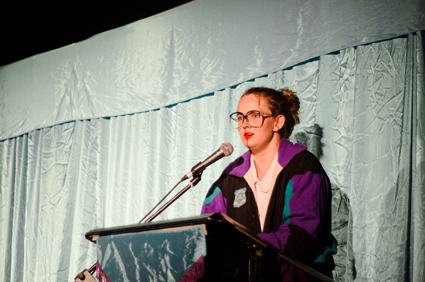
Zoe Coombs Marr, And That Was The Summer That Changed My Life
photo Lucy Parakhina
Zoe Coombs Marr, And That Was The Summer That Changed My Life
zoe coombs marr
Zoe Coombs Marr’s solo show And That Was The Summer That Changed My Life (see also RT98) references a musical, West Side Story, via the flute solo she played in a medley at her high school band camp. Wearing goofy glasses and a purple, green and black nylon track top, Coombs Marr grips the sides of the lectern, breathes heavily into the microphone and starts her presentation with laborious definitions from the dictionary. From here, she segues into a more general reminiscence of her only-slightly-misspent youth, in which she taped Xena, hoped to become a lesbian, wondered about kissing, worried about flute playing and distracted herself from her worry by thinking about kissing again. Towards the end of the show, Coombs Marr confesses that she has since found out there is no flute solo in West Side Story; her febrile teenage mind simply magnified the importance of playing the regular flute line. Does it matter? Probably not, she concludes—such moments of grace are rare and can’t be recreated. Or can they? In relating her stories of lust, loss and dinosaurs, Coombs Marr creates a show that is both cringe-worthy and cool.
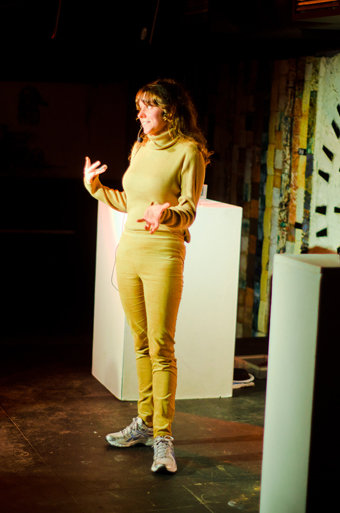
Claudia O’Doherty, What Is Soil Erosion?
photo Lucy Parakhina
Claudia O’Doherty, What Is Soil Erosion?
claudia o’doherty
If Marr’s is a show about a show that never was, then Claudia O’Doherty’s What Is Soil Erosion? is about a show that cannot be—primarily because television producers refuse to commission her 26-part series on the basis that it is “formless.” The same cannot be said of her beige pants, however, which are as tight as her top is loose. Dressed as a dorky scientist, O’Doherty proceeds to plough her way through every single episode, combining corny presentational poses, crappy graphics and a series of ridiculous surveys. Interspersed among the facts about soil erosion (yes, really), are asides about her cold sores and accidental abortion as well as some free shopping vouchers. It’s occasionally too long, but with some judicious editing, this will be a tight, punchy comedy.
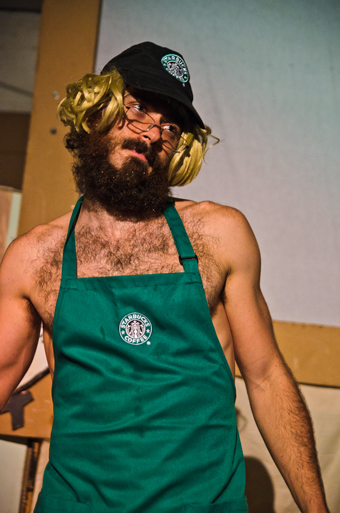
Dr Brown, Because
photo Lucy Parakhina
Dr Brown, Because
dr brown
During O’Doherty’s show I share a joke with the man standing beside me, who turns out to be the comedian Dr Brown. His show Because is hard to describe, but “silent stand-up” or “post-clown” comes close. In the opening sections, he brings an audience member onto the stage, gets a second member to help hoist the first onto their shoulders and then asks the other spectators to cheer. This, of course, requires another round of applause, so a third spectator is brought onto the stage to lift the second etc. In another section, a baby doll cries so he wraps it in a nappy, spraying the audience in the process, and carries it upstairs—we see nothing but hear a stomp and an ominous silence. In the final scene, he strips down to a Starbucks apron, performs an elaborate dance that involves manipulating the apron strings with his buttocks, and then sits down, lifts up his apron and pours water on his groin, shouting accusingly, “What do you want from me?!” He stalks up the stairs, leaving the audience thinking this the funniest and weirdest thing they’ve seen in ages.
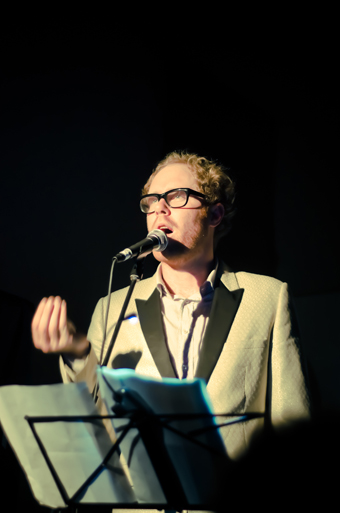
Miles O’Neil, Miles O’Neil’s World Around Us
photo Lucy Parakhina
Miles O’Neil, Miles O’Neil’s World Around Us
miles o’neil
The same venue also hosts Miles O’Neil’s World Around Us. O’Neil manages to conjure several worlds: with some found Super 8 footage, which is projected onto a bed sheet, he evokes the 1970s; with stories of discovering pornography with his friends, he calls to mind the 1980s; and with stories he’s borrowed from a taxi driver and a homeless man, among others, he manages to evoke our contemporary world. In between these found images and stories, he also plays a few songs and the combination makes for a simple, subtle and unassuming show.
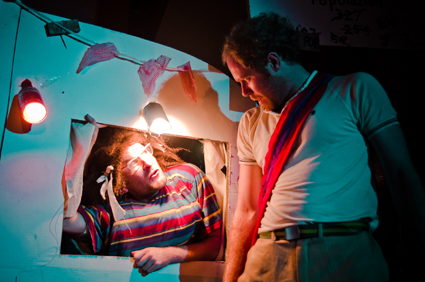
The Suitcase Royale, The Suitcase Royale’s Test Flight#1
photo Lucy Parakhina
The Suitcase Royale, The Suitcase Royale’s Test Flight#1
the suitcase royale
O’Neil also appears in The Suitcase Royale Test Flight#1, which is slightly less subtle, with its endless fart jokes and cross-dressing. Set in a town that is being attacked by zombats (zombie wombats), the show follows the travails of the last survivors as they pursue the creatures across the country, into caravan parks and eventually into a cave. It feels unfair to review something that is so obviously still in development, so suffice to say that Test Flight#1 is stylish (in the sense that it is recognisably Royale) but not especially substantial, and will need a few more sorties before it can soar.
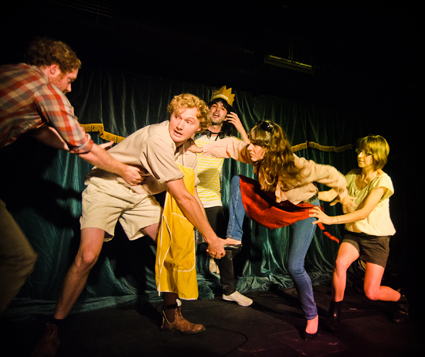
Pig Island, Cab Sav
photo Lucy Parakhina
Pig Island, Cab Sav
cab sav
The festival concludes with Cab Sav, a sort of contemporary performance variety night. Lara Thoms opens proceedings by standing centre-stage in a watermelon-coloured leotard; her arms flop and she occasionally bends at the waist. It’s not clear who or what she is until a motor starts and an inflatable man, of the kind you find in car yards and beer ads, bursts into life and across the stage. Matt Prest appears sans pants, which is all the more disturbing because he is wearing a very dorky, chunky knit cream sweater on top. Post (Coombs Marr, Mish Grigor and a man who is standing in for the very pregnant Natalie Rose) presents an excerpt from their forthcoming show (Who’s the Best?) alongside a segment from an old one (the bounceathon from Shamelessly Glitzy Work, RT98).
Brown Council stand shame-faced as an audience member is summoned to read out a terrible review of their performance A Comedy—slightly amusing but somewhat disingenuous since the show has, for the most part, had a very favourable reception (see RT98, RT101, RT101).
Then the members of Pig Island (Nick Coyle, Charlie Garber and Claudia O’Doherty), who have appeared separately throughout the festival, reunite for a short skit in which they have to save Imperial Panda—one last show about a show. Finally, Panther contrives an exercise whereby we move our chairs, stand in pairs and shout “my darling, I love you” at each other. Then the music cuts in and we find that we have cleared ourselves a dance floor.
This final night serves as a microcosm for the festival as a whole, in the sense that it looks deceptively casual but is in fact carefully produced. Though there’s no explicit festival theme, the work presented at Imperial Panda nevertheless shares a sensibility—relentlessly intertextual and often intermedial, but just as often determinedly lo-fi and DIY. There is also a resolute refusal to appear too serious about or within the work, despite the fact that it takes serious ambition to produce each show and the festival as a whole. Beyond this, what stays with me is the event’s infectious sense of fun. Perhaps it’s about nothing more and nothing less than the pleasures of performance or, more accurately, meta-performance.
Rhubarb Rhubarb, Some Film Museums I Have Known, performers Natalie Randall, Nick Coyle, writers Eddie Sharp, Kenzie Larsen with Natalie Randall, Nick Coyle, set design, holograms Will Mansfield, director Eddie Sharp, Old Fitzroy Theatre, Feb 18-March 12; Masterclass, writer-performers Gareth Davies, Charlie Garber, GoodGod Danceteria, March 4-12; And That Was The Summer That Changed My Life, writer-performer Zoe Coombs Marr, Redfern Town Hall, March 11-13; What Is Soil Erosion?, writer-performer Claudia O’Doherty, GoodGod Danceteria, March 17-19; Dr Brown, Because, writer-performer Philip Burgers, March 18-19; Miles O’Neil’s World Around Us, writer-performer Miles O’Neil, Helen Rose Schausberger Labortorium, March 15; The Suitcase Royale, The Suitcase Royale Test Flight #1, writer-performers Joseph O’Farrell, Miles O’Neil, Glen Walton, Helen Rose Schausberger Laboratorium, March 17-19; Imperial Panda Festival, Sydney, March 4-20; www.theimperialpanda.com
RealTime issue #102 April-May 2011 pg. web
© Caroline Wake; for permission to reproduce apply to realtime@realtimearts.net
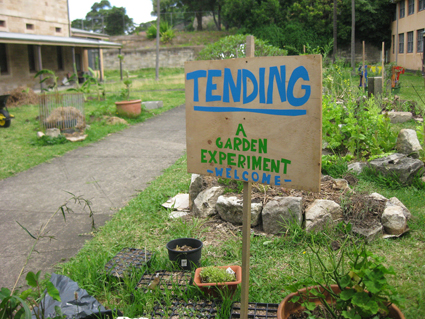
Tending: A Garden Experiment
photo courtesy of the artists
Tending: A Garden Experiment
ENCASED BY OLD SYDNEY SANDSTONE, COVERED IN ANCIENT SPONGY KIKUYU AND FASHIONED INTO QUARTERS BY QUAINT HEXAGONAL SHAPED CEMENT FOOTPATHS, A ONCE OVERLOOKED COURTYARD AT SYDNEY COLLEGE OF THE ARTS (SCA) HAS BEEN GIVEN SOME EXTRA TENDER LOVING OF LATE.
how does your garden grow?
Since mid-2010 Lucas Ihlein and Diego Bonetto’s project Tending has gently moved in and things have started to grow, both in the garden and online via their blog. Tending is a kind of artists’ garden experiment that engages with the biological, social, aesthetic and institutional fabric of a small, but not altogether insignificant, place.
The project was conceived in collaboration with Ross Gibson (Professor of Contemporary Arts, SCA) as a potential research focus for staff and students that would work towards materialising the garden theme of the college’s Callan Park location. For Gibson, the significance of the project lies in the way that gardens are “like comprehensible and pleasurable versions of the messy contemporary world—interactive, delicate, hard work, generative, social, beautiful, requiring constant care and co-operation.”
The initial plan, explains Ihlein, was to occupy a piece of land at the entrance of the college and have the garden function as a de facto go-between for the two worlds of “art school” and “rest of the world.” However, bureaucratic and institutional complexities made this difficult and Tending was made to adapt and cooperate with its current, more internal, location in the courtyard next to the SCA library. It is within this context that Ihlein and Bonetto have described Tending as a process that “intervenes, lightly.” Like a newly emergent eco-system Tending has fractured as much as it has fused through soft day to day interventions and co-operation(s)—that have gently pushed at what is possible artistically, institutionally, biologically and socially.
Located in Kirkbride Park, on the historic grounds of Callan Park, in the former-psychiatric-hospital-cum-contemporary-art-school, Tending’s relationship to place is decisive. Callan Park is an environment where the contemporary politics of arts education, mental health and urban land development are forever simmering below the surface of the rolling parklands and iconic architecture that fill 61 hectares of contested real estate on the shores of Sydney Harbour. Quietly, yet ever present, older Indigenous and settler histories embedded in the local area also linger.
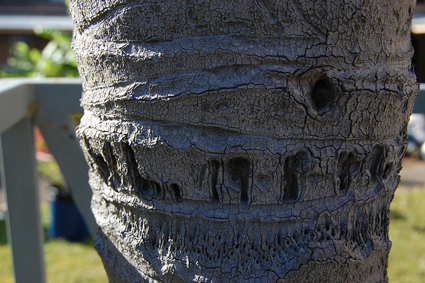
W.L. 19-8-44, Tending
photo courtesy of the artists
W.L. 19-8-44, Tending
The wider environment that SCA inhabits is dense, rich and also massively under explored. Having moved from Balmain into the Kirkbride Block in the early 1990s the college is still in the process of finding and settling into the full potential of its relationship to place. The fact that Ihlein and Bonetto describe their weekly digging and planting sojourns as a “mental health day” is illustrative of the delicate and subtle connections to place that have come into operation through this art project. Fragments of people’s lives—names and dates etched long ago into the trunks of over-looked palm trees—come to the fore through the process of Tending. On the blog the artists ask: “Who were W.L. and D.W.?…and what was going on for them in these decades, during and after the war?”
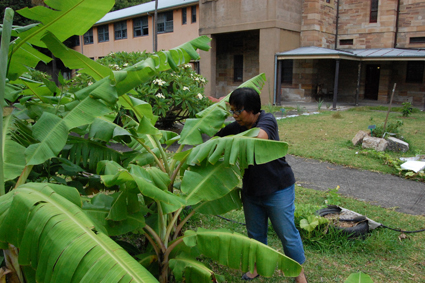
Betty harvesting some banana leaf, Tending
photo courtesy of the artists
Betty harvesting some banana leaf, Tending
process and products
There is a genuine warmth and unpretentiousness that characterises the project both in person (on site) and via the blog (online). Characters emerge in the unfolding narrative of Tending—characters that can just as easily be plants as people. The blog’s quaint attention to detail begins to feel like a slow meditative reality TV show, whose production team would be carrying around copies of Michel de Certeau’s The Practice of Everyday Life alongside their shovel. Some characters stay longer than others, such as Tending’s switched on VIP Betty whose knowledge has gone deep into that soil, but they all contribute to an interesting balance of contention and co-operation, order and unruliness that sits at the core of Tending as an artwork in process.
But Tending is not an artistic process without products. Indeed, gardens themselves provide ideal places to explore the dynamic between process and product. As Ihlein explains, “one would quickly tire of digging the soil if, season after season, there were no yields.” Some products Ihlein and Bonetto have seen emerging from the collective labours of Tending include: physical pleasure; a clear mind; some lettuces, cucumbers, pumpkins and lots of basil; knowledge about what to plant at different times of the year; new friendships; heated discussions about the definition of art; some small wages; a series of guest lectures; an open-air studio; an improvement in soil quality; a restful place on campus…
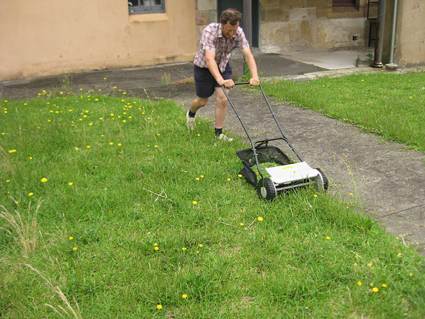
Grass, Tending
photo courtesy of the artists
Grass, Tending
tending the future
The future of Tending is uncertain. The artists are looking into ways of enabling the garden at SCA to continue indefinitely, mapping out a kind of “management hand-over” to students and staff at the college, which the artists have jokingly likened to the process of America pulling out of Iraq. There are also pending grant applications that could potentially see the project extend over to the main campus of Sydney University as part of a new Diabetes and Obesity research facility, whereby gardening-as-art will be put to practical use beyond its current context. In the process we might just see the estrangement that all too often exists between disciplines further collapse.
In his essay, The Emancipated Spectator, Jacques Rancière argues that emancipation is not so much about “activation” over a “passivity” that is perceived to be inherent in spectatorship, but rather about breaking down the very oppositions that inform this kind of hierarchical understanding of things. Rancière concedes that an emancipated community is in fact a community of storytellers and translators. In this sense Tending is producing a community of gardeners that bring worms to the surface of the soil and sprout edible fruits from seeds as much as they uncover over-looked histories, confront artistic norms and forge new relationships with people and place.
Lucas Ihlein and Diego Bonetto, Tending, Sydney College of the Arts, www.tending.net.au
This article was first published in our May 24 e-dition.
RealTime issue #103 June-July 2011 pg. 4
© Alana Hunt; for permission to reproduce apply to realtime@realtimearts.net
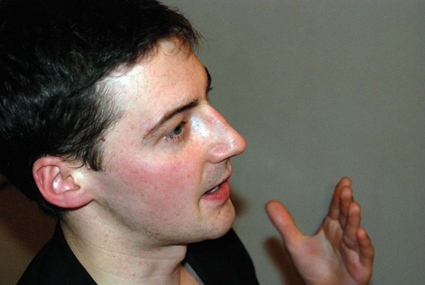
Matthew Lorenzon
photo courtesy of the author
Matthew Lorenzon
Bio
I was turned on to music at the age of 14 when I heard the Prelude to the first Bach cello suite on Neon Genesis Evangelion. I had moved from the Blue Mountains to suburban Adelaide when I was young and perhaps the cello made me remember something about the mountains. Two years later I played the piece to get into a special interest music school and started playing cello in bands, string quartets and orchestras, before starting a music degree at the Elder Conservatorium of Music. I quickly developed RSI and turned to studying musicology, English, philosophy and cultural studies at Adelaide University and Melbourne University, with a little stay at McGill University in Montreal. I am currently completing a PhD in musicology at ANU on the rapport of music and philosophy in the works of the philosopher Alain Badiou and the composer François Nicolas. Apart from writing I like to compose for theatre and art installations. I still like the mountains but don’t get to them very often.
Exposé
I write because I want to know how ideas are relevant to music and vice versa. Getting the right match is very difficult, but a discursive approach to a work, not just a performance or a composer, can be really enriching for listeners. To this end RealTime is Australia’s most important and proactive source of writing on contemporary music. You can make that extra discursive leap and don’t have to be afraid of it being edited out before the final print.
The Astra Chamber Music Society is another long-standing and praiseworthy institution, not least because I get to sing with them every week. Where else can you premiere a new Australian work one moment, then sing some obscure baroque requiem mass or early 20th century atonal number the next, alongside much better singers so you feel like you’re in the best karaoke bar ever? It’s Astra’s 60th birthday this year. Happy birthday Astra. I love you.
I am also developing a vested interest in disability access in the arts, having been quite immobilised by ankylosing spondylitis this past year. Perhaps mentioning my ank. spond. blog here (www.ismethotrexatekillingme.blogspot.com) will inspire me to post more on it.
We should keep on talking in the face of music. We will be shamed by the music, but that is necessary to learn to listen again.
Recent articles for RealTime
RT102 new music theatre in utero: carnegie 18, full tilt
RT102 new music: challenge as fun: mona foma, hobart
RT101 bringing chamber opera home: chamber made opera, living room opera
RT100 an unbelievable urge: the itch, chamber made opera
RT98 opera for ipad: helen gifford’s exile
Update 2013: Matthew also now runs the blog Partial Durations in association with RealTime: http://partialdurations.wordpress.com
RealTime issue #103 June-July 2011 pg. web
© Matthew Lorenzon; for permission to reproduce apply to realtime@realtimearts.net
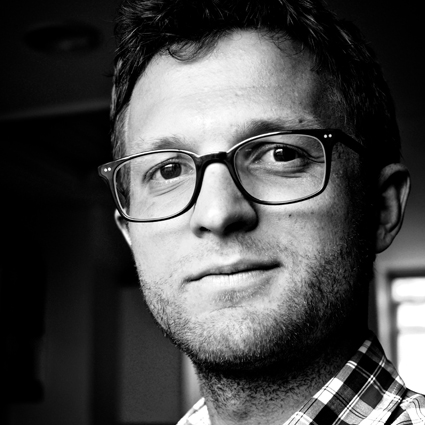
Carl Nilsson-Polias
photo courtesy of the author
Carl Nilsson-Polias
Bio
I grew up in Adelaide and Göteborg as a bilingual Greco-Swedish-Australian kid who wanted to play soccer for AC Milan. Then, a role in a French company’s production at the 1996 Adelaide Festival gave me a deludedly halcyon image of what it was to be involved in the arts. I hold Barrie Kosky personally responsible for curating this corruption of innocence. So, I went to the Victorian College of the Arts as an acting student and now I am an actor, an Artistic Associate with The Hayloft Project, a member of the Green Room panel for Independent Theatre and an out-of-form soccer player.
Exposé
I began writing on theatre, film, music and dance while studying at VCA. In a curriculum that focused entirely on kinaesthetic learning there was no outlet for the written word, very little space for intellectual discourse or the communication of ideas beyond the sheltering walls of the studio. In response, I founded a student blog, wangled review tickets from theatres, cinemas and festivals, encouraged my friends to join me and suddenly became an editor and critic. Today, my writing about the arts coexists with my own artistic practice—I see both fundamentally as means to communicate and interrogate.
Recent articles for RealTime
dance massive feature kinetics: sculpted & danced: connected, chunky move
dance massive feature turning the tables, working the audience: branch nebula, sweat
dance massive feature erupting from the archive: balletlab, amplification
RT99 from screenplay to stage: ivo van hove, director, cassavetes opening night
RT90 the mask speaks: hong kong arts festival: the wooster group, akram khan & juliette binoche
Other writing
see my blog www.carlnp.com.au
RealTime issue #103 June-July 2011 pg. web
© Carl Nilsson-Polias; for permission to reproduce apply to realtime@realtimearts.net
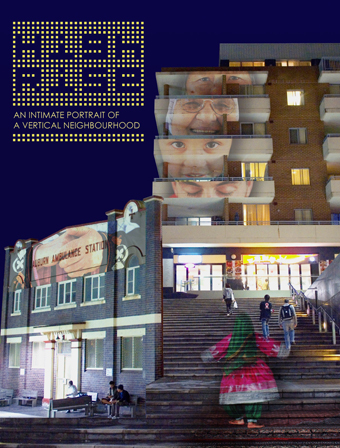
HighRise: An Intimate Portrait of a Vertical Neighbourhood
photo Joanne Saad, design ragingyoghurt.org
HighRise: An Intimate Portrait of a Vertical Neighbourhood
an intimate portrait of a vertical neighbourhood
In the wake of the MCA’s The Begin-Again in Hurstville (see RT103), comes the HighRise project in Auburn. Like The Begin-Again, HighRise is a large-scale public sound and video installation work that has been developed over several months through the collaboration of community residents and artists. The artists include award-winning photographer Joanne Saad, visual artist and producer Khaled Sabsabi (RT98, 2010 Helen Lempriere Travelling Arts Scholarship recipient) and producer Lina Kastoumis (previously at Urban Theatre Projects); the residents are from the Auburn Central high rise complex. The result is a work that includes nearly 100 individual videos, which will be projected in an open-air setting in the courtyard and on the buildings of Auburn Central. HighRise begins on Thursday May 26 and runs over three nights, with two 30-minute screenings per night. HighRise: An Intimate Portrait of a Vertical Neighbourhood, Auburn, May 26-28; find them on facebook
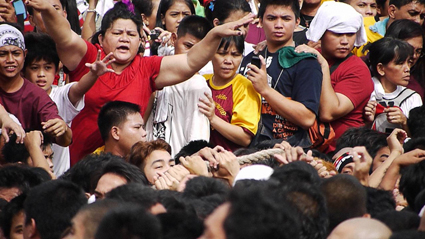
Within and Without
photo Datu Arellano
Within and Without
anino again
If you saw The Folding Wife (RT79), then you will already know the alchemy that happens when Deborah Pollard, Paschal Daantos Berry, Valerie Berry and Manila-based multi-media artists Anino Shadowplay Collective collaborate. This time they are working on a project called Within and Without, which is billed as “a contemporary performance and event that explores the city of Manila, through representation of its landscape, history and culture” (press release). Blurring the lines between theatre and visual arts, this project will take over both the gallery and performance spaces of Blacktown Arts Centre. Bookings essential. Deborah Pollard, Valerie Berry, Paschal Daantos Berry and Anino Shadowplay Collective, Within and Without, Blacktown Arts Centre, June 22-July 2, www.artscentre.blacktown.nsw.gov.au
tiny revolutions & deviations from the norm
In another exciting collaboration, Perth-based pvi collective (RT44, RT95, RT99) are working with Vitalstatistix in Port Adelaide at the Waterside Workers Hall for three weeks. On May 27, they host tiny revolutions, a show-and-tell where they discuss “the role intervention plays in their practice and their latest body of work as well as subtle (and not so subtle) strategies for mis-behaviour in public spaces and their philosophy of instigating tiny revolutions through art” (website). Then in mid-June, they present transumer: deviate from the norm, which was commissioned for the 17th Biennale of Sydney in 2010, and has been made in the ‘awaiting development’ landscape of Port Adelaide with a team of local artists. The show is billed as “darkly playful site-based intervention, inviting audiences to undertake tiny acts of resistance against their built environment” (website). pvi collective at vitalstatistix, tiny revolutions, May 27; transumer: deviate from the norm, June 10-12, Port Adelaide; www.vitalstatistixtheatrecompany.blogspot.com
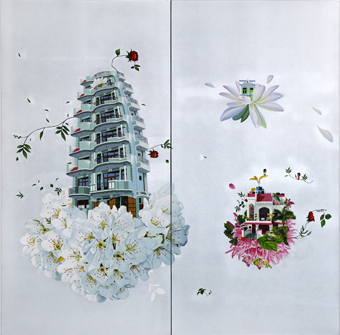
Thukral and Tagra, Dominus Aerius elegance – 6, 2008, acrylic and oil on canvas
image courtesy the artists and Gallery Barry Keldoulis, Sydney
Thukral and Tagra, Dominus Aerius elegance – 6, 2008, acrylic and oil on canvas
cosmo-popular cultures
La Trobe University Museum of Art (LUMA) is showcasing selected works by leading artists from Australia, India and the Philippines in the exhibition Vernacular Cultures and Contemporary Art. The exhibition features “contemporary artists whose work incorporates expressions of indigenous and/or locally specific popular cultures” and examines such themes as “surf culture, karaoke, religious iconography, street advertising and popular architecture” (press release). The artists include Raqs Media Collective (RT43), Thukral and Tagra, Fiona Foley (RT94, RT94), Scott Redford (RT55), Sangeeta Sandrasegar (RT77), Maria Cruz, Mark Salvatus, TV Moore (RT57), Hoang Tran Nguyen, and Ken Botnick and Diana Guerrero-Maciá. The exhibition program also features a public lecture by the renowned Indian artist Pushpamala N (RT65) on June 9 and a performance by the Australian art rock band The Histrionics on June 10. Vernacular Cultures and Contemporary Art from Australia, India and the Philippines, curator Ryan Johnston, LUMA La Trobe University Museum of Art, May 5-June 15, www.latrobe.edu.au/luma
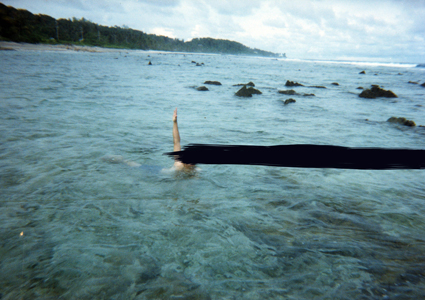
Carl Warner and Ross Gibson
protection (2011, detail)
c-type photographs and blackboard paint
image courtesy of the artists and UQ Art Museum, source material courtesy of Fryer Library, the University of Queensland
Carl Warner and Ross Gibson
protection (2011, detail)
c-type photographs and blackboard paint
art and refuge
The University of Queensland Art Museum is hosting three related exhibitions from June 11 to August 7. The first is Waiting for Asylum: Figures From an Archive. Working with the Fryer library archive of refugee ephemera, collaborating artists Ross Gibson (RT54, RT91), and Carl Warner interpret the precarious position of the asylum seeker past and present. The second is Collaborative Witness: Artists Responding to the Plight of the Refugee, in which artists “challenge one-dimensional portrayals and become not only witnesses, but also collaborators on the complex story of those seeking asylum” (press release). The show includes works by Benjamin Armstrong, Lyndell Brown and Charles Green, Jon Cattapan, Tim Johnson and Karma Phuntsok, Rosemary Laing (RT58, RT85, David Ray, Judy Watson (RT69) , and Guan Wei (RT81). The third show is John Young: Safety Zone, which responds to the hidden history of the ‘Rape of Nanjing’, when a group of 21 foreigners saved the lives of 300,000 Chinese by sheltering them in the city’s international ‘safety zone.’ Caroline Wake, author of our Archive Highlight Art & Asylum: Politics, Ethics, Aesthetics, will be reviewing the shows in RealTime 104. Waiting for Asylum: Figures From an Archive, curators Prue Ahrens and Michele Helmrich, project researcher Gillian Whitlock; Collaborative Witness: Artists Responding to the Plight of the Refugee, curators Prue Ahrens and Michele Helmrich, John Young: Safety Zone, University of Queensland Art Museum, June 11-Aug 7; www.artmuseum.uq.edu.au
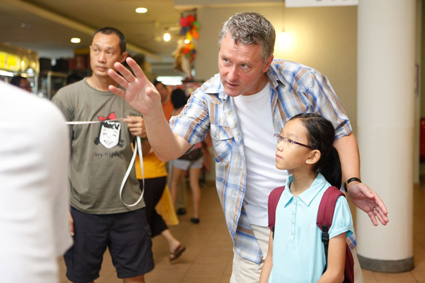
Joe Lawlor from Desperate Optimists on the set of Tiong Bahru in Singapore 2010
photo courtesy of the artists
Joe Lawlor from Desperate Optimists on the set of Tiong Bahru in Singapore 2010
desperate optimists: community on screen
The Dublin-born, UK-based performers and filmmakers Desperate Optimists are visiting Australia to screen Tiong Bahru, the unique outcome of their engagement with a Singaporean community. Made by Joe Lawlor and Christine Molloy and co-produced by Singapore-based Dan Prichard, it’s part of an innovative series titled Civic Life. It screened at Rotterdam and Dublin film festivals earlier this year, at the Festival of Ideas in Bristol and IndieLisboa in May. There’s an interview with the makers in Sight and Sound. The Civic Life blog includes a trailer for Tiong Bahru, photographs and another interview. The wide screen cinematography, seamless continuity and the cumulative evocation of social life around a small district are seductive, focusing on small pleasures and low-key dramas. Community members perform with ease and conviction. Desperate Optimists’ extensive Australian program includes screenings, talks and workshops at ACMI, Footscray Community Arts Centre; Metro Screen, AFTRS, Performance Space and ICE, and as part of the Sydney Film Festival at the Art Gallery of NSW. See the websites of the above organisations for dates
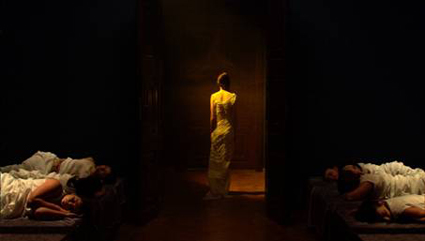
Penelopa
the patience of penelope
The award-winning writer-director Ben Ferris’s art film Penelopa is finally being released, screening at the Art Gallery of NSW and the Nicholson Museum, University of Sydney. Penelopa is the first Australian-Croatian co-production and is adapted from Homer’s tale of Penelope, depicting her psychological struggle as she waits 20 years for her husband to return from the Trojan War. The film “draws on the long-take filmmaking style of art film directors such as Andrei Tarkovsky (The Mirror), Akira Kurosawa (Seven Samurai) and Bela Tarr (The Man from London)” (press release). Penelopa, Nicholson Museum, University of Sydney, June 15, Art Gallery of NSW, June 25; www.penelopa.com.au
RealTime issue #102 April-May 2011 pg. web
© RealTime ; for permission to reproduce apply to realtime@realtimearts.net
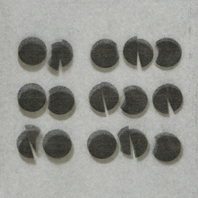
Decibel, Disintegration: Mutation
hellosquare recordings, CD, cube046
http://hellosquare.bandcamp.com/
In their manifesto, Decibel state that they “seek to dissolve any division between sound art, installation and music.” Their CD Disintegration: Mutation represents more than just sound. To appreciate it fully, you must read the liner notes, visit their webpage and preferably see a performance either on YouTube or, ideally, live.
Decibel blend acoustic instruments (strings, woodwinds) with electronics (keyboards, turntables, Max MSP processing and networking) and you can watch their scrolling graphic scores online, adding a significant dimension to the appreciation of the music. I’ve not seen them live, but it’s clear that Decibel performances are dramatic presentations and the abstract sounds are given degrees of meaning or emphasis depending on the depth of the listener’s engagement.
Track 1 is Decibel founder Cat Hope’s composition “In the Cut,” for cello, bass clarinet, bass guitar and a turntable playing a specially made recording of a descending tone. “In the Cut” uses pitch, texture and timbre to chilling effect. Inspired by the eponymous Susanna Moore novel (which became a Jane Campion film), it starts with a squealing violin note that’s joined by cello and clarinet. The pitches slowly fall, the instruments eventually detune and the sound becomes chaotic, suggesting entropic decay, as if music itself is collapsing. Behind the arrhythmic, sinking line is a low, droning, all-consuming rumble. Music like this is best heard on a PA at high volume to add visceral impact.
Track 2, Hope’s “Kuklinski’s Dream,” begins with an ethereal, breathy whisper that segues into the more strident and densely woven timbres of bass clarinet and strings that echo and mock the eerie whispering sound. The dreaminess of the high-pitched opening becomes nightmarish when we discover that the sound source is the bowing of knife blades, referencing the murder-weapon of late Mafia hitman Richard Kuklinski, after whom the work is named. The sight of the bow hairs being shredded in live performance would add a macabre visual element—a musical instrument that self-annihilates. The graphic score is based on fragments of Kuklinski’s signature so that the work, for three carving knives, bass clarinet, double bass, cello and processing, directly embodies his persona as well as his apparatus. Whereas “In the Cut” represented entropy through pitch and distortion, “Kuklinski’s Dream” represents murder.
Lindsay Vickery’s “Transit of Venus” is a gently developing progression of tones and timbres involving live processing and performer-specific click tracks that, together with the graphic score, guide the pitch, dynamics, textures and time periods. Hope’s double bass creates a bubbling sensation that sits below the fluttering violin and pizzicato cello, and each instrumental voice ebbs and flows intriguingly as the work unfolds. The final work is Vickery’s “Antibody,” which was evidently inspired by biological mutation, and in which Malcolm Riddoch’s organic looking online visual representation maps the harmonics graphically, showing how they grow outward from the central tone. The same visual representation could be made for any sonic event, but it seems essential to the concept for this work. The sound is a densely layered haze of momentary gestures and structural threads, and the cello line is especially interesting. The longest track at 14 minutes, for alto flute, bass clarinet, violin, cello, keyboard and processor, it has an engagingly quizzical musicality.
Whereas Decibel has previously foregrounded works by other composers, this CD comprises compositions by its members demonstrating their manifesto. Hope’s compositions contrast with Vickery’s in the nature of the inspiration for the work. Hers have great psychological and theatrical impact, while the lush complexity of his suggests a more conventional musicality, as you focus on the timbres, textures, resonances and formal development. Both composers continue the interrogation of sound in space and the possibilities for the generation and realisation of sound, though the CD format unfortunately restricts spatial awareness. They also mix improvisation with graphic scores, programmed electronics and click tracks, making for a highly complex set of performance parameters, though these are undetectable when listening to the CD, as is any aleatoric variability from performance to performance.
Disintegration: Mutation is absorbing and resolved work that extends the aesthetic that has emerged over recent years in blending the sonically possible into the demandingly-but-satisfyingly musical. The CD’s title suggests Decibel’s approach —the disintegration of conventional music and the mutation of sound into new forms.
Chris Reid
http://decibel.waapamusic.com/
See also Darren Jorgensen’s review of Decibel’s performance of Alvin Lucier’s work in RT97; Jonathon Marshall’s review of Decibel’s Tape It! performance in RT94; and download a sample from RealTime’s SoundCapsule #1.
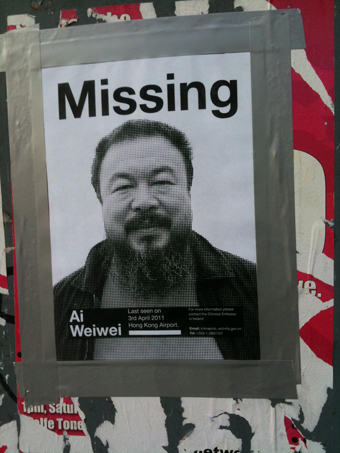
Ai Weiwei missing poster
photo stunned
Ai Weiwei missing poster
“IF IT CARRIES ON LIKE THIS IT WILL BECOME LIKE THE CULTURAL REVOLUTION.” THAT WAS THE ASSESSMENT EXPRESSED TO ME RECENTLY BY A WELL-KNOWN CHINESE CREATIVE FIGURE REGARDING THE CURRENT SITUATION IN THE PEOPLE’S REPUBLIC. IF THAT SOUNDS LIKE HYPERBOLE, THE FACT THAT THESE WORDS ARE BEING UTTERED BY SOMEONE OLD ENOUGH TO REMEMBER WHAT THE MAOIST ERA WAS ACTUALLY LIKE IS INDICATIVE OF THE PREVAILING MOOD AMONGST THE NATION’S ACTIVIST AND CREATIVE COMMUNITIES.
On Sunday April 3 China’s best known contemporary artist Ai Weiwei was taken from Beijing airport as he attempted to board a flight for Hong Kong. He has not been heard from since. Ai, who is also a prolific filmmaker, architect and designer, has long been an outspoken critic of the Chinese government. His domestic and international profile, however, led many to believe he was unlikely to suffer the harsh treatment dealt out to many lesser-known opponents of the regime. In the words of The Guardian’s Jonathan Jones on April 4, his arrest is being interpreted as an attempt to “stamp out the idea that any individual is greater than the law of the state.”
The “law of the state” in this case—as in many others—is proving very flexible, since Ai Weiwei has not been formally charged and none of his friends or family, including his wife and mother, is aware of his current whereabouts. Various other members of Ai’s circle have also been arbitrarily detained for varying periods, and his associates Wen Tao, Zhang Jinsong, Hu Mingfen and Liu Zhenggang are all still missing at the time of writing.
Unfortunately Ai Weiwei’s case is just the tip of the iceberg. After anonymous calls for a Chinese “Jasmine Revolution” emulating recent uprisings in North Africa and the Middle East circulated online in mid-February, the Chinese authorities moved swiftly to neutralise the perceived threat. Initially political activists were targeted, including lawyers and well-known bloggers. In March, they also began exerting pressure on parts of China’s creative community.
The China Human Rights Defender website claims, “The Chinese government has criminally detained a total of 39 individuals since mid-February.” Seventeen of these are still in detention, nine have been charged and are awaiting trial and three have already been sent to camps for “re-education through labour.” The claims are supported by a map detailing the names and locations of those detained (see chrdnet.org). Earlier this month the same organisation reported around 200 others have been placed under other various forms of “soft detention”—in other words, house arrest.
In addition, an unknown number of people across China have been subject to a ramping up of intrusive surveillance, harassment and interference in their daily lives. On March 18 for example, I visited the academic and documentary filmmaker Ai Xiaoming (no relation to Ai Weiwei) at Sun Yat-Sen University in Guangzhou. Ai has made numerous low budget documentaries focusing on controversial issues such as the spread of AIDS in rural China through unregulated blood collections.
After a translator and I met Ai on campus, we headed to her nearby apartment. As we approached her residential block around five minutes later we were intercepted by a man—presumably a plain-clothed security officer—who addressed Ai Xiaoming by name and asked what we were doing. Our questioner was joined a few moments later by another man and a woman, while two other men stood watching a few metres away. None of the group was uniformed or offered any form of identification. The first man informed Ai Xiaoming that we needed to accompany him to the campus security office (Bao wei chu), while the woman asked my translator and I our names, occupations and places of origin.
Ai Xiaoming agreed to accompany the ‘officers’ if they let my translator and I go. As my companion and I made a hurried exit we were followed by other plain-clothed personnel into the subway station next to the campus.
Ai Xiaoming later contacted me and stated she suspects her phone is tapped and her email account has been hacked. Our experience shows her apartment is certainly under surveillance, although she says she was unaware of this until the incident on March 18.
Although certain filmmakers and artists have long been under surveillance and subject to phone taps, since the 1980s it has been rare for Chinese authorities to physically prevent artists meeting with foreigners. It is a disturbing development that the kinds of restrictions that more radical political activists have long endured are now being extended to established creative figures.
In more bad news for China’s film community, on April 18 organisers announced the cancellation of the Eighth Documentary Film Festival China, an event staged annually since 2004 in the far-flung Beijing suburb of Tongzhou. The festival is one of a handful of regular events in China showcasing films made outside the country’s state-controlled approval system. The 2011 edition had been planned for the first week of May. Artistic Director Zhu Rikun was quoted in the English-language edition of Chinese newspaper The Global Times as saying, “We cancelled it ourselves. The overall situation was tense, and we had received a lot of pressure.” The report did not elaborate on the nature of the pressure or its source.
In the current environment, Chinese-born foreign nationals have found that holding a foreign passport does not necessarily protect them, as the Australian novelist and blogger Yang Hengjun discovered when he disappeared in the city of Guangzhou on March 27. He resurfaced the following weekend and was allowed to return to Australia via Hong Kong, but he declined to elaborate on his experience, telling The Age, “I can’t keep having media attention and continue my pursuit of democracy in China…The more questions I answer outside China, then the less I can do inside.”
It remains to be seen whether the present crackdown represents a longer-term hardening in the government’s attitude or simply a panicked, typically heavy-handed response to events overseas. Either way, it’s a sobering reminder of the immense arbitrary power wielded by China’s ruling party and how quickly cultural liberalisation can be wound back when the state feels threatened. Even if all the detained figures are released tomorrow, the atmosphere of fear will linger, intensifying the already pervasive self-censorship that exists in China’s media and cultural spheres. This is, of course, precisely the intention. The message from the authorities is clear—the right to creative expression in China is on always on notice.
RealTime issue #102 April-May 2011 pg. web
© Dan Edwards; for permission to reproduce apply to realtime@realtimearts.net
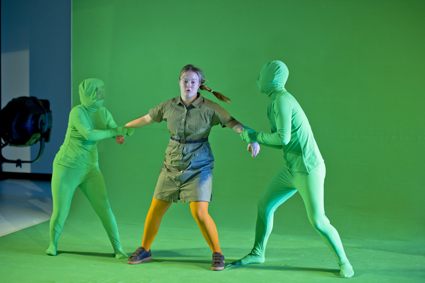
Katherine Evans (centre), Jianna Georgiou and Ciaran Woods, Take Me There
photo Chris Herzfeld
Katherine Evans (centre), Jianna Georgiou and Ciaran Woods, Take Me There
I AM NOT YOUNG ENOUGH TO HAVE GROWN UP WITH MY MEMORIES PLAYING BACK ON HOME VIDEO. WHILE OTHER FAMILIES IN THE SUBURBAN 1970s HAD SUPER 8, MY FAMILY HAD SLIDE SHOWS ON A BED SHEET AND PHOTOGRAPHS STUCK IN ALBUMS. MY MEMORIES OF OTHER TIMES AND PLACES ARE ORDERED, THEREFORE, BY THE SHOOT-AND-SNAP OF PHOTOGRAPHY, NOT BY THE ZOOM-AND-FLOW OF HANDHELD VIDEO. I SEE THE IMAGE BUT I DON’T REMEMBER. OR IF I DO, THEN I CAN ONLY RECALL THE FREEZE-FRAME OF THE SINGLE SHOT.
In Take Me There from Restless Dance, performer Alice Kearvell recounts her birthday memories. She begins remarkably with birthday number one: “lots of cuddles with my family and had a BBQ and dessert and I got shy.” By her second: “I was screaming and my brother put his hands over his ears. And I remember my sister was there and we had party food and dessert.” And for her third: “I think we went out for tea, no lunch, that’s right, at the cafe. And I remember had party food and dessert.”
Alice mediates these memories on stage from a green expanse of chroma-key, while live video of her performing is composited with home videos of her birthday celebrations. The resulting memory-flow is streamed to seven screens strapped-up around the stage. Other performers enter singing “Happy Birthday” and carrying gas-filled party balloons. But this is not a re-enactment. It is more a tribute to the displacements of home video, flowing into memory formations of the self elsewhere—at other times, in other places.
Beside the green expanse and video screens, the 12 performers in this work occupy a space—designed by Gaelle Mellis—which is as empty as a waiting room with its row of plastic chairs and a single potted plant. Where else do they want to go?
Dana hangs out with some friends in an abandoned house. Matt wants to be anywhere, stretched out and relaxed, lying on the grass. But Jennie can’t get anywhere, wherever that may be. Kathryn wants to go downtown to the rough-and-tumble of the inner city. Lorcan wants to go to Ireland. Courts goes swimming in the pool and Dana remembers snow falling in Romania.
The video magic of chroma-key makes these escapes of memory and imagination possible on stage and screens—or so it seems. When Lorcan flies to Ireland, he takes his seat in the aeroplane as the ensemble joins him from the side. Together they dance the gestures of the flight attendants’ safety routine. Once in Ireland, Lorcan—Leprechaun-like—makes another performer disappear from the screen by draping her in green.
When Kathryn goes downtown, she is moved and bumped around by two performers dressed in green. Against a backdrop of city lights and traffic, she jumps and twists and screams unheard. On the screens, of course, her manipulators have disappeared; she is tossed and turned by the unseen forces of the city.
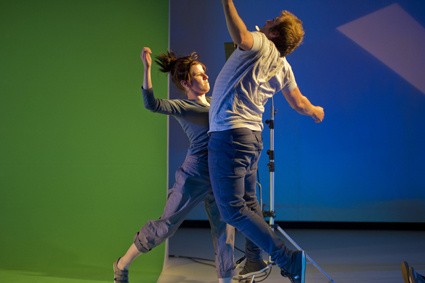
Courts White and Jesse Rochow, Take Me There
photo Chris Herzfeld
Courts White and Jesse Rochow, Take Me There
The work itself bears the traces of its making. Director Daniel Koerner asks the audience in the program—as he may have asked the performers in rehearsal—“If you had the chance to go anywhere, do anything, where would you go? What would you do there?” Technological conceits of appearance and actuality are exposed in the performance with humour, tracing the cruelty of those liberal injunctions to “be who you want to be” and “go where you want to go.”
Aspirations to overcome the constraints of time, place and physical capacity are mediated by memories and technologies. But the gap between individual aspirations and the uniformity of ensemble behaviour is not so thoroughly explored. Individual imperatives to “take me there” are met with collective actions in response that set limits and refusals. The performance only tolerates one aspirant at a time, who must return to the ensemble if they are to grant freedom to another.
There is even something slightly petulant about the work’s imperative. “Take me there” sounds like an unruly child speaking to a reluctant parent, or a traveller of privilege issuing instruction to a driver—as if the speaker is incapable of getting there without the generosity of our contribution.
Between the individual and the ensemble there is also scope for mid-scale interactions less explored in this work. In choreographies of twos and threes and fours, performers say to us and others, not “take me there,” but “we’re getting out of here!”
Come Out Festival, Restless Dance Theatre, Take Me There, director Daniel Koerner, assistant director Philip Channells, designer Gaelle Mellis, lighting designer David Gadsen, composer Ian Moorhead, Adelaide Festival Centre, March 25-April 2; www.restlessdance.org
This article was first published as part of the May 10 e-dition.
See also RealTime’s Archive Highlight on Arts & Disability, with an introduction by Anna Hickey-Moody
RealTime issue #103 June-July 2011 pg. 38
© Jonathan Bollen; for permission to reproduce apply to realtime@realtimearts.net
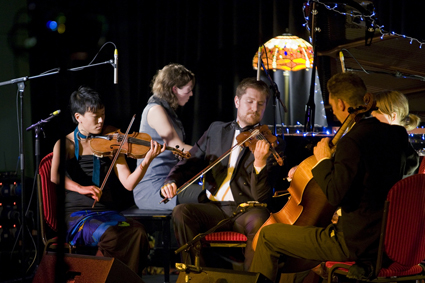
Sunwrae String Quartet
photo courtesy of the artists
Sunwrae String Quartet
new music to your ears
There’s a busy two months ahead for new music lovers. First, Mike Majkowski (Earbash and RT97) and Decibel (RT94, RT97) join forces for concerts in Canberra and Sydney. Decibel will also be performing at PICA in the second of three concerts there with new works by ensemble members Lindsay Vickery and Cat Hope as well as by Chris de Groot, Thomas Meadowcroft and John Cage as well as an arrangement of Scott Walker’s Benito’s Dream (you can hear some of Decibel’s work in our Sound Capsule and keep an eye out for Chris Reid’s review of their CD in our next e-dition). The Sunwrae String Quartet is also on tour (and will be reviewed in RT103), with concerts in each capital city, a guest appearance at the Camden Heaven Music Festival in Port Macquarie and a trip to Vietnam. Finally, Canberra is again hosting its adventurous International Music Festival (see our 2010 review). Decibel and Mike Majkowski, Canberra, May 14, www.thestreet.org.au and Sydney, May 15, www.cityrecitalhall.com; Decibel, Concert 2, PICA, June 20, www.decibel.waapamusic.com; Sunwrae String Quartet, Eavesdropping Tour, May 5-June 9, www.sunwrae.com; Canberra International Music Festival, May 11-22, www.cimf.org.au
music theatre at home
Chambermade Opera continues its series of intensely intimate operas (The Itch, Another Lament and Target, with Dwelling Structure, subtitled “An Opera in 8 Time Use Episodes.” Citing poet Emily Dickinson, CMO suggests “you will dwell in possibility, a doorless house??,” in what promises to be a highly unusual work created by sound artists Madeleine Flynn and Tim Humphrey with writer Cynthia Troup and “visual assemblage by Neil Thomas, and neighbourly interruptions by The Suitcase Royale.” Chambermade Opera, Dwelling Structure, May 26-28, www.chambermadeopera.com
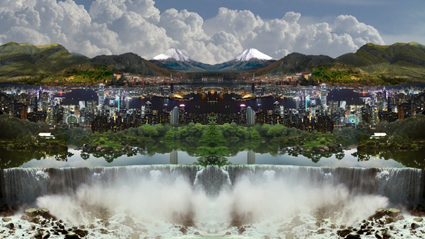
Kit Wise, Xanadu 2009, HD video installation, silent 6:00, mirrored glass, Digital production Darin Bendall, an Experimenta Commission
image courtesy of the artist
Kit Wise, Xanadu 2009, HD video installation, silent 6:00, mirrored glass, Digital production Darin Bendall, an Experimenta Commission
old new media
From new music to new media…if you missed it in Melbourne last year, you can catch Experimenta: Utopia Now on tour at the Mornington Peninsula Regional Gallery. The show features the work of Patrick Bernatchez (Canada), Michael Burton (UK), Cao Fei (China), Christopher Fulham (Australia), Christian Jankowski (Germany), Laurent Mignonneau & Christa Sommerer (France/Austria), Scenocosme (France), Kit Wise (Australia) and dynamic Melbourne duo, Van Sowerwine & Isobel Knowles, all of whom investigate the double meaning of utopia as the “good place” and/or “no place.” In her RealTime review last year, Saige Walton said the “selected works ranged from joyous and humourous to desolate and unnerving” (RT96). There’s more media art to be seen at the Brisbane’s Gallery of Modern Art. Drawing from its collection, the gallery’s latest exhibition, Physical Video, explores the use of the body in video art, featuring work from the early 1970s through to the present day. Artists include Bruce Nauman (US), Jun Nguyen-Hatsushiba (Japan/US/Vietnam, RT46, RT50), Dennis Oppenheim (US), James Oram (New Zealand) and Mike Parr (Australia, RT102) among others. Experimenta: Utopia Now, Mornington Peninsula Regional Gallery, May 12-June 19; www.experimenta.org; Physical Video, GoMA, Brisbane, May 14-Sept 4 2011; www.qag.qld.gov.au
the winner: douglas sirk box set
Our thanks to all the entrants in our competition who informed us how the Madman Douglas Sirk box set would improve their lives. The winner was Melbourne choreographer Phillip Adams, who wrote:
“For those of you who know me, I am strictly a 50s man. From Featherston chairs to Palm Springs chic and my car—a 1959 Merc. The delights and the details in the designs of Sirk’s films in the box set would keep me enthralled hour after hour. The inspiration from the set decorations alone would be like a home magazine filled with retro gems: styles, suits, gloves, backdrops, kitsch all rolled into one. Well, I might even go as far as having Written on Wind playing nonstop as my bedhead artwork. Sirk is a man after my own heart.”
The 9-DVD box set of the great films of the 1950s master of aesthetically and socially incisive Hollywood melodramas, Douglas Sirk, was generously provided by Madman Entertainment.
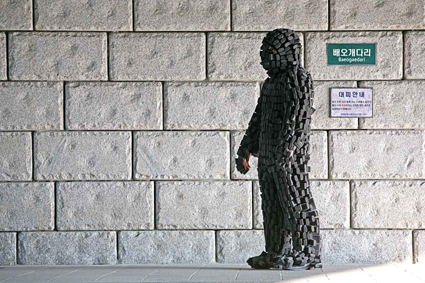
Ash Keating, Label Land (2009), Human Rights Arts and Film Festival
photo courtesy of the artist
Ash Keating, Label Land (2009), Human Rights Arts and Film Festival
the politics and poetics of human rights
It’s 50 years since the United Nations Refugee Convention was established, which makes the Human Rights Arts and Film Festival particularly relevant this year. The festival starts in Melbourne with a program that includes film, visual art, poetry, theatre and public forums. The films will be shown at ACMI in a week-long program of documentaries, animations and shorts. The Asylum Seeker Resource Centre is presenting Not Only My Story, a play in which refugees collaborate with artists such as Yumi Umiumare (RT39, RT71, RT94). There is also artwork by Ash Keating (RT77, RT86, RT91). Smaller versions of the film program will tour Canberra, Alice Springs, Brisbane, Sydney, Byron Bay, Adelaide and Perth. Human Rights Arts and Film Festival, Melbourne May 12-22, national tour May 26-June 12, www.hraff.org.au
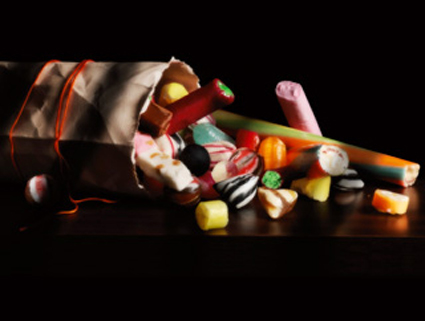
Robyn Stacey, Tall Tales and True, Stills Gallery
photo courtesy of the artist
Robyn Stacey, Tall Tales and True, Stills Gallery
head out to head on
Head On Photography Festival is now in its second year. There are over 130 indoor and outdoor exhibitions, events, seminars and workshops across Sydney over seven days. Of particular interest is Robyn Stacey’s show Tall Tails and True at Stills Gallery, Paddington, as well as the group exhibition at Roslyn Oxley9 featuring Destiny Deacon (RT66), Bill Henson, Tracey Moffatt (RT102), Julie Rrap, Patricia Piccinini (RT43), TV Moore (RT57), Isaac Julien (RT42, RT97) and Anne Zahalka. There are also two interesting tours on offer: one to a camera obscura in Centennial Park and another of the Powerhouse Museum’s basement, which houses a considerable collection of 19th century cameras and photographs. Head On Photo Festival, May 5-June 11, www.headon.com.au
RealTime issue #102 April-May 2011 pg.
© RealTime ; for permission to reproduce apply to realtime@realtimearts.net
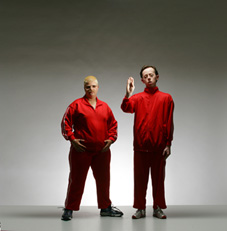
Sonia Teuben, Simon Laherty, Small Metal Objects
photo Jeff Busby
Sonia Teuben, Simon Laherty, Small Metal Objects
[This introduction was written in November 2011. New links will continue to be added to the list below. Eds.]
Since 1997, RealTime has displayed a strong commitment to the work of artists with disabilities, providing perspectives on disability offered by art. This archive highlight offers a snapshot of the landscape of disability arts in Australia from the RealTime archive, drawing attention to two central issues that become apparent when canvassing the body of work the magazine has produced about disability and art. First, disability arts practices consistently redefine and expand sensory catalogues of what it is to be human—offering new ways in which the experience of humanity can be felt. Second, writers face unique challenges when articulating these new geographies of humanity produced by artists working in the field.
the disability arts landscape
If we were to read disability arts in Australia as a body, the backbone would clearly be the work of Back to Back Theatre and Restless Dance Theatre, companies whose work demonstrates enduring excellence and global impact. Formed in 1987, Geelong-based Back to Back is Australia’s first professional performing arts company for people with disabilities. Their acclaimed work has toured nationally and internationally making the most significant global impact of the disability arts companies in Australia. Experiments with staging (Food Court), sound (Small Metal Objects), explorations of the audience-performer relationship (Small Metal Objects again) and a remarkable intellectual curiosity (Soft) are some of the hallmarks of Back to Back productions. Thematically, their catalogue features explorations of the body, love, sex, self-perception and space.
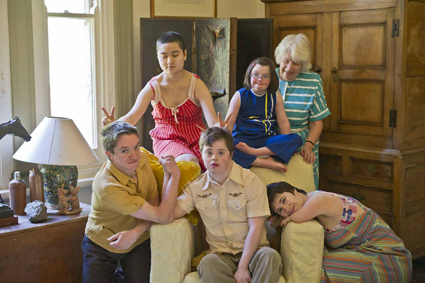
Next of Kin, Restless Dance Theatre
photo Chris Herzfeld
Next of Kin, Restless Dance Theatre
Adelaide-based Restless Dance Theatre is a slightly younger company with a central performance ensemble of young disabled and non-disabled dancers aged 15 to 26. Restless also has a touring company, with dancers and collaborators engaged on a professional basis to make works for touring nationally and internationally. Since 1991 Restless has explored issues of independence (Safe From Harm, Rebel Rebel), and intimacy (Bedroom Dancing, The Heart of Another Is a Dark Forest) while consistently expanding dance theatre (Unspoken Outloud) as a form.
Other notable contributions to disability arts in Australia include the work of Melbourne’s Rawcus and Adelaide-based No Strings Attached, along with the significant presentation of works by other artists and companies at festivals such as Wataboshi, High Beam and Art of Difference, which bring disabled artists together as a community.
finding the words
Disability arts practices often act as a compass that maps radical articulations of humanity. These mappings offer ways of rethinking and feeling cultural spaces of culture typically outside of the mainstream. While these sensory explorations are the work of the largely very accomplished artists, their practices demand other kinds of work for writers and audiences. This is the labour of adequately expressing new sensations in relation to cultural forms and professional practices. Reading the back catalogue of writing about disability and art in RealTime, there are moments where new philosophies of arts practice are articulated in synergistic journalism (RT22; RT53) and inspired intellectual offerings are made in response to live art (RT82). At other points, disability acts as a fault line on which writers stumble and which they conceptually struggle to cross.
In this way, disability and art come together to pose two challenges. The first of these is the call for audiences to feel anew and, in so doing, to brave unique sensations. Dominant tropes of disability representation continue to haunt the work of artists with disabilities, writers and the experiences of disabled people—namely, the freak show (RT62) and disability as other. But these well-worn notions are challenged by the work of many artists (RT22) and writers (RT69) who are able to offer new ways of putting disability politics into print.
The second challenge posed by the union of disability and art is exactly this call for journalists and industry professionals to journey into thought in order to offer words that do some kind of justice to the material cartographies created through enmeshments of disability and art. In his book S/Z, French semiologist and cultural theorist Roland Barthes famously characterised a “writerly text” as one which “is ourselves writing, before the infinite play of the world is traversed, intersected, stopped, plasticized by some singular system (Ideology, Genus, Criticism) which reduces the plurality of entrances, the opening of networks, the infinity of languages” (Paris: Seuil, 1970). For Barthes, reading such work should not be “a parasitical act, the reactive complement of a writing,” but rather a “form of work.” In rising to understand the moments in which writers adequately express sensations of disability art in words, it is exactly this form of work in which we, as readers, must learn to engage.
Anna Hickey-Moody
back to back theatre
bodies, flocks and crowds
john bailey: melbourne international arts festival
the genesis: ganesh versus the third reich
john bailey: interview, back to back theatre members
you will live forever: back to back theatre, the democratic set
tim x atack
the image that pierces: back to back & the necks, food court
caroline wake
more than a walk in the park: back to back theatre’s tour guide
alexandra crosby
small metal objects: beautiful logic
andrew templeton
small metal objects: the invisible revealed
eleanor hadley kershaw
returning the audience’s gaze: back to back theatre’s food court
carl nilsson-polias
small metal objects: deals and dependencies
bec tudor
small metal objects: ordinary guise
lucy hawthorne
small metal objects: an intimate conversation and the perfect front
judith abel
small metal objects: magic micro culture clash
alex ferguson
theatre of speed: back to back theatre’s inside the angel house
keith gallasch
enabling art: back to back theatre’s soft
lalita mchenry
a fish out of water: back to back theatre, fishman
maryanne robinson
restless dance theatre
transported: between memory & desire: restless dance theatre, take me there
jonathan bollen
comeout 09: artful reciprocity: restless dance theatre, unreasonable adults
jonathan bollen
character issues: the heart of another is a dark forest, rawcus theatre and restless dance theatre
john bailey
safe risks: restless dance company, safe from harm
jonathan bollen
autonomy and the emerging artist: restless dance company, rebel rebel
jonathan bollen
the dance of words: restless dance company and australian dance theatre, inspace
helen omand
restless men: restless dance company, laminex man and starry eyed
helen omand
inner utopias: restless dance company, starry eyed
helen omand
dancing with time’s arrow: restless dance company, in the blood
anne thompson
rawcus theatre
character issues: the heart of another is a dark forest, rawcus theatre and restless dance theatre
john bailey
telling silences: rawcus theatre company, hunger
john bailey
the rewards of risk: born in a taxi and rawcus theatre company, not dead yet
john bailey
next wave: the circus deep inside: rawcus theatre company, sideshow
mary-ann robinson
potential versus perfection: rawcus theatre, designer child
keith gallasch
other
the body in the shadow of the past
benjamin brooker: vitalstatistix, take up thy bed & walk
ironies of the inevitable: no strings attached theatre of disability’s tom the loneliest
jonathan bollen
not about disability: britain’s candoco dance company
zsuzsanna soboslay
festivals
wataboshi: the seeds grow
lalita mchenry
high beam: beyond the performance/therapy axis
lalita mchenry
interviews, forums
the uses of art: regional arts australia meeting place 2004
chloe smethurst
new spaces, other intelligences: interview with bruce gladwin
keith gallasch
shifting perspectives: on art and disability at art of difference
janice florence
in-space: conversations with movement, interview with ingrid voorendt
anne thompson
enabling dance: interview with sally chance
anne thompson
splitrec, CD20
www.splitrec.com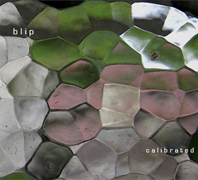
Blip, Calibrated
There is always a certain sense of paradox about improv recordings. As Jim Denley (one half of Blip with Mike Majkowski) notes: “However entangled in the moment when generated, the finished products are compositions…reviewed, edited, mixed, mastered, fixed, made repeatable and generally fussed over” (‘Networks, Playfulness and Collectivity: Improv in Australia, 1972-2007’, Experimental Music: Audio Explorations in Australia, ed G Priest, UNSW Press 2009).
Interestingly the CD notes reveal Calibrated to be the sixth attempt to record this musical relationship, which has been developing since 2008. So while the album offers the first 42 minutes of a two-hour session as it happened, in the moment and unedited, the process of spontaneous music making together with the idea of a fixed recorded outcome, is in fact well rehearsed.
The result of these rehearsals is a very clear sense of engagement, or entanglement as Denley calls it, between the two artists. Over the three tracks, Denley (alternating between alto sax and flutes) and Majkowski (on double bass, pitch pipes, objects and voice) traverse an evershifting terrain, without losing sight of each other, or their individual footing.
Track 1, “Pod,” explores quiet sparse textures, mixing Denley’s spittle-filled wash with Majkowski’s faraway strangled vocals. A half-melody from Denley, almost a by-product of other activities, merges with the reediness of Majkowski on pitch pipe, which he plays simultaneously with quiet percussive bass bowing. A sense of turn taking, or question and answer develops as plucks and tongue tocks stab at each other, culminating in a long, multi-tonal note from Denley.
Track 2, “Oat”, thickens up the tonal material from “Pod,” with Majkowski making long low whooping sounds by rubbing his hand over the body of the bass which interplay with Denley’s hollow reedy tones. Deep bass bowing creates a sense of tension, while the application of a balloon to the bass induces a kind of chirping over which Denley concludes with mournful, gliding sax squeals.
Tracks 1 and 2 are relatively short so by the final 21-minute track, “Branes,” the duo is primed. Majkowski starts suddenly with the harsh, sustained rattles produced by applying a plastic cassette case to the bowed strings, sounding like a castanet player on speed. Denley counters with impossibly long flute notes that devolve into a quasi-syllabic play heightened by Majkowski with intense skittering of the bow over the strings. At one juncture they explore pitch extremes: Majkowski drags out low bass notes as Denley produces piercing piccolo peeps. At another Majkowski introduces bell tolls with each pluck of a bass string, while Denley emulates a kind of digital serialism on overblown flute. As often happens the ending that presents itself is ignored creating an epilogue of sax death throes with a definitive hard-edged stop. It’s been quite a journey.
An important element to capturing the spontaneous nature of this kind of music is to maintain a sense of the room in which the moment is recorded, and the clear miking of Denley in the left channel and Majkowski in the right is unfussy. It allows for a sense of orientation, particularly helpful as it seems that Majkowski can produce woodwind-like sounds, and Denley can produce string timbres. Of course, mixing this up and fusing the sound sources might offer an intriguing sensory complication. Having seen these artists play live, I have a clear idea of the extended techniques involved in the making of many of the obscure sounds, but I wonder how a listener without the memory of the gestures of performance would experience the recording—perhaps it would make the textural and timbral material even more heightened. With or without prior experience of these artists live, however, it is impossible not to appreciate that the music-making undertaken on Calibrated is part of a rich and ongoing conversation between two of Australia’s most engaging improv artists.
Gail Priest


































